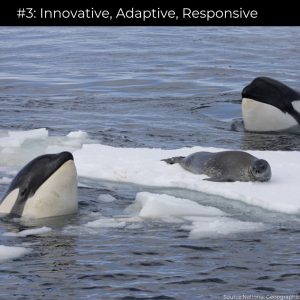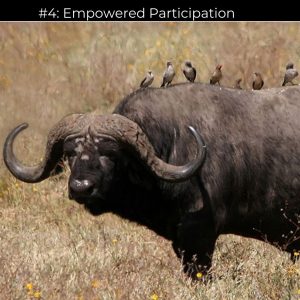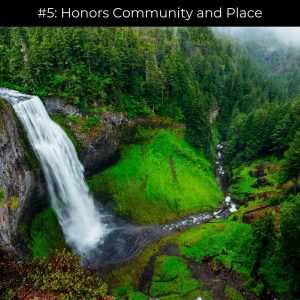Regenerative Economics 101
In 2015, John Fullerton wrote Regenerative Capitalism, a paper that describes eight principles that could underpin a new economic system — one that delivers shared prosperity on a thriving planet. In the paper, he writes,
The universal patterns and principles the cosmos uses to build stable, healthy, and sustainable systems throughout the real world can and must be used as a model for economic-system design.
Below are Natural Capitalism Solutions’ interpretation of the eight principles. We share the original text of each principle, describe how it shows up in nature, how it shows up in business, and what an individual can do to embody it and bring it more to life in the world. Our hope is that these bring the principles to life so that we can all take part in transforming economic systems to ones that are healthy for people and the planet.
Regenerative Principle #1: In Right Relationship
The Principle: “Understands that the ecosphere is composed of nested systems, living and nonliving. Recognizes that the human economy is embedded in both culture and the ecosphere and must operate in dynamic and cooperative relationship with them, respecting cultural needs and planetary limits. Allows for critical value adding exchanges to occur at all scales in reciprocal relationship, in contrast with commoditized transactions.”

The Principle in Nature: While nature is often portrayed as a kingdom of competition, in reality, cooperation is much more the law of the land. There are countless examples of animals — even humans — cooperating to accomplish mutual goals. Sometimes the cooperation is even interspecies.
The Principle in Business: There is a growing movement of businesses that see their role as more than simply maximizing shareholder value. B Corporations prioritize environmental and social goals as much as fiscal ones. They understand that they can leave the world a better place than it was when they started — and do so profitably. Ultimately, business is one part of human civilization, which is just one part of the web of life on the planet. Viewing business as in relationship with the rest of the planet changes how it functions. This perspective can turn business into a force for good and a powerful ally in solving some of the most challenging problems of our day.
What You Can Do: Observe the instances of cooperation around you all the time — in nature, in the business world, and in human culture more broadly. Embody this principle by reflecting on the opportunities for cooperation and healthy interactions, and take them when possible. For example, businesses can broaden their relationship with local businesses and vendors. As an individual, seek collaboration and advice from neighbors on your projects, such as gardening, creative work, or business endeavors. Support organizations that focus on being in right relationship with nature and society.
Regenerative Principle #2: Views Wealth Holistically
The Principle: “Defines wealth in terms of the well-being of the ‘whole’ rather than only what is reducible to money. Redefines wealth to mean multiple kinds of capital beyond financial wealth. Recognizes that numerous dimensions of human and natural capital cannot be measured in monetary terms but must be nurtured as intrinsic components of holistic wealth.”
The Principle in Nature: Healthy ecosystems provide abundant resources that allow each species that relies on it to thrive. There is no exchange of money and yet there is value everywhere. The Kalahari Bushmen live by this principle as well, as described in the book Affluence Without Abundance. When nature is operating in an undamaged state, it generates holistic wealth that sustains life.
The Principle in Business: Businesses that embody the regenerative principles know that wealth is more than just financial. They have human capital, in the form of happy employees that are well taken care of; they have cultural capital by offering a space for positive, diverse, and empowering interactions to take place; and they value natural capital, by creating value chains that enhance the health of the planetary space they share. The Capital Institute’s Field Guide offers examples of organizations that use wealth and money in innovative ways to bring about a more regenerative world.
What You Can Do: Take stock of the various forms of wealth you hold other than financial. Perhaps it’s a satisfying social network, access to parks and natural spaces, the ability to pursue curiosity and develop intellectually, or spiritual fulfillment. Support community organizations that emphasize multiple forms of capital, such as Slow Money in Boulder, and seek to build the various types of wealth that can provide deeper fulfillment than money.
Regenerative Principle #3: Innovative, Adaptive, Responsive
The Principle: “In a world in which change is both ever-present and accelerating, the qualities of innovation and adaptability are critical to health. It is this idea that Charles Darwin intended to convey in this often-misconstrued statement attributed to him: “In the struggle for survival, the fittest win out at the expense of their rivals.” What Darwin actually meant is that: the most “fit” is the one that fits best i.e., the one that is most adaptable to a changing environment.”
 The Principle in Nature: Crows are known to throw nuts onto the road, where cars run them over and crack the hard shell, revealing the prize they then swoop down and claim. Chimpanzees use stone tools to open nuts. Bees do an elaborate dance to communicate to other members of their colony how to reach a source of pollen. Orca whales collaborate to create waves big enough to slide seals off sea ice to aid in their hunt. Nature is full of examples of flora and fauna inventing ingenious ways to adapt, solve problems, cooperate, and make life easier and better — just like human innovators.
The Principle in Nature: Crows are known to throw nuts onto the road, where cars run them over and crack the hard shell, revealing the prize they then swoop down and claim. Chimpanzees use stone tools to open nuts. Bees do an elaborate dance to communicate to other members of their colony how to reach a source of pollen. Orca whales collaborate to create waves big enough to slide seals off sea ice to aid in their hunt. Nature is full of examples of flora and fauna inventing ingenious ways to adapt, solve problems, cooperate, and make life easier and better — just like human innovators.
The Principle in Business: The application here is clear: humans have a knack for solving problems in creative ways. Businesses that do that well are the ones that survive. Creative business models are often the best at solving tough problems in a way that also benefits local communities and the planet.
What You Can Do: Everyone has creative abilities, even if they haven’t been intentionally exercised recently. Challenge your habitual ways of thinking about social problems – be willing to let go of ideas about what should work and what has already been done. Consider solutions or ideas that seem unreasonable or impossible, as once more options are on the table, innovative solutions can emerge.
Regenerative Principle #4: Empowered Participation
The Principle: “All healthy living systems are self-organizing and operate through continual negotiation with one another and in constant ‘conversation’. So too, a healthy human economy requires the empowered participation of individuals and groups, negotiating in their own enlightened self-interest as they naturally promote the health of the whole.”
 The Principle in Nature: There are numerous instances in nature of empowered participation that lifts up both parties. For example, red-billed mackerels and Cattle Egrets are known to land on the backs of African Buffaloes. The birds pick insects out of the buffalo’s hide and wounds — a win for both parties. Similarly, pilot fish accompany sharks closely and even enter their mouths to pick away scraps of food and parasites. These relationships and “conversations” emerged organically as each species pursues its enlightened self-interest.
The Principle in Nature: There are numerous instances in nature of empowered participation that lifts up both parties. For example, red-billed mackerels and Cattle Egrets are known to land on the backs of African Buffaloes. The birds pick insects out of the buffalo’s hide and wounds — a win for both parties. Similarly, pilot fish accompany sharks closely and even enter their mouths to pick away scraps of food and parasites. These relationships and “conversations” emerged organically as each species pursues its enlightened self-interest.
The Principle in Business: Many businesses have recently embraced models of decentralized leadership as ways to ensure everyone has a voice, buy-in to the company’s goals, and empowering professional relationships. Groups ranging from startups to YouTube, from Alcoholics Anonymous to the Apache Native Americans, have used this type structure to create empowering and healthy collectives.
What You Can Do: Recognizing that the best scenarios are ones where everyone benefits, as opposed to zero sum contests, seek ways to strengthen these interactions in the world. Support policies that are good for both people and the planet. For example, in 2012, the Global Energy Assessment found that investing in energy efficiency for buildings worldwide would cost $15 trillion through 2050, but result in a cost savings of $57 trillion — while also creating jobs. Many policies that are good for the planet are also beneficial to people and the economy, and our elected officials need to know we support them. In business, seek to bring as many diverse stakeholders into the conversation as possible, instead of restricting decision-making to smaller, closed groups.
Regenerative Principle #5: Honors Community and Place
The Principle: “Each human community consists of a mosaic of peoples, traditions, beliefs, and institutions uniquely shaped by long-term pressures of geography, human history, culture, local environment, and changing human needs. Honoring this fact, a Regenerative Economy nurtures healthy and resilient communities and regions, each one uniquely informed by the essence of its individual history and place.”

The Principle in Business: In a world seemingly dominated by big business, small enterprises can actually have important advantages that should be strengthened. For example, in many developing countries with large populations working in smallholder agriculture, local populations have vast stores of knowledge particular to the wildlife, biodiversity, weather, and soil conditions specific to their area. The holders of this knowledge can often have more success than larger businesses who attempt to apply one-size-fits-all techniques. Similarly, the Field Guide provides examples of businesses that catalyze local energy and knowledge to tailor solutions that wouldn’t be possible without special place-based knowledge.
The Principle in Nature: Through evolution and adaptation, there are countless ecological niches on the planet – and as many species that have specialized to perfectly fit in them. For example, on Caribbean islands, there are multiple species of anoles (lizards) that are each perfectly adapted to live on different parts of a tree: one thrives in the leafy upper portions of the tree, another is suited to live on branches and twigs, yet another does best on the trees main trunk, and the fourth does well in grassy underbrush near the base of the tree. Clearly, each of these species has found their place, and knows how to thrive in unique circumstances.
What You Can Do: Think about the ways your locality is unique and worthy of celebration. Take pride in your place by being a steward – participate in activities that enhance its health like track pick-ups and place-based gardening techniques.
Regenerative Principle #6: Edge Effect Abundance
The Principle: “Creativity and abundance flourish synergistically at the “edges” of systems, where the bonds holding the dominant pattern in place are weakest. For example, there is an abundance of interdependent life in salt marshes where a river meets the ocean. At those edges the opportunities for innovation and cross-fertilization are the greatest. Working collaboratively across edges – with ongoing learning and development sourced from the diversity that exists there – is transformative for both the communities where the exchanges are happening, and for the individuals involved.”

The Principle in Business: The results are in, and they are clear: businesses that have more diverse employees are more innovative, create more profits, and have more satisfied employees (who do better work). Diverse perspectives help groups make more informed decisions, lead to greater creativity, and foster environments of respect. This business “edge effect” is a feature of more regenerative economic systems.
The Principle in Nature: Where different ecosystems collide, there is often greater abundance and diversity of plant and animal species. Natural Capitalism Solutions in based in Boulder County, where the Front Range of the Colorado Rockies meets the Great Plains to the east. These habitats are unique areas that demonstrate the principle that nature thrives where diversity is celebrated.
What You Can Do: Notice the ways that diversity in its many forms – in your social network, the cultures you’ve experienced, the ideas you consider, the foods you try – can enrich your life. In your workplace, see if there are ways to introduce unconventional perspectives, or bring in people who have them. While specialists have some strengths, generalists who are well-versed in a variety of topics can often have creative insights or valuable ideas. Look for linkages between disparate areas of your knowledge.
Regenerative Principle #7: Robust Circulatory Flow
The Principle: “A regenerative material economy mimics the metabolic process found in resilient living systems, up taking what we now discard as ‘waste’ in an ongoing, productive, circulatory, and value-enhancing flow. Likewise for the circulatory, value-enhancing flow of information and money.”
The Principle in Business: Companies are starting to wake up to the possibility of reducing their waste streams and having their product life cycle be a circular loop as opposed to a one way street that dead ends in a landfill. For example, Patagonia created its Common Threads initiative, so that any piece of their clothing can be repaired, reused, or donated, and ultimately avoid landfills. Similarly, Japan has instituted a nationwide recycling program; 98% of its metals and 95% of its trash get recycled and turned into new products.

The Principle in Nature: In nature, there is no waste. A fallen log becomes a home to fungus and food for termites. When Native Americans hunted buffalo, they used each part of the animal for a productive purpose. Nature is a cyclic, regenerative system in which each part serves a purpose — even the ones we might label “waste.”
What You Can Do: Take a look at the picture above. What do you see — trash, or fertilizer? Consider that much of what we call waste can actually be quite useful. There are systems that can be put in place that give waste incredible value. For example, Sweden has a robust recycling program — 93% of its glass, 47% of its plastic, and 82% of its paper is recycled. Whatever gets thrown away or can’t be recycled is cleanly burned to produce heat and electricity. In total, 99% of Sweden’s waste is reused in some way. Find ways to reduce or reuse “waste” in your own life or introduce them into your company.
Regenerative Principle #8: Seeks Balance
The Principle: “Being in balance is more than just a nice way to be; it is actually essential to systemic health. Like a unicycle rider, regenerative systems are always engaged in this delicate dance in search of balance. Achieving it requires that they harmonize multiple variables instead of optimizing single ones. A Regenerative Economy seeks to balance: efficiency and resilience; collaboration and competition; diversity and coherence; and small, medium, and large organizations and needs.”

The Principle in Business: Too often business has been a force that pushes natural and social systems towards imbalance – but many are now changing their priorities so that they are helping restore balance. B Corps, mentioned above, balance the profit motivate with an equal emphasis on people and planet. Organizations like the King Grove Organic Farm and the Savory Institute focus on regenerative agricultural practices that not only create profit but restore the health of their surrounding ecosystems. Business can be a force that helps social, ecological, and economic systems operate in a healthy balance.
The Principle in Nature: Nature has inbuilt feedback loops that help it stay in balance. When a deer population’s numbers are lower than can be sustained by their habitat, their numbers tend to grow. If they grow too much, they are re-balanced by depleting resources until they are scarce and by greater activity by predator. This same balance-seeking happens at a much smaller scale, too – when we get sick, our bodies mobilize our natural defenses to restore a healthy equilibrium. And at greater scales, ecosystems of the Earth are always responding and adapting to the ever-changing climate, ocean, and ecological systems. Wherever life manifests, it seeks balance.
What You Can Do: Balance is a theme that runs through each of the Regenerative Principles. Things simply work better when they are in balance. Consider things in your own life that feel out of balance and look for ways to restore equilibrium. Support businesses, policies, and politicians that aim to restore balance and help create systems that deliver shared prosperity on a thriving planet.
